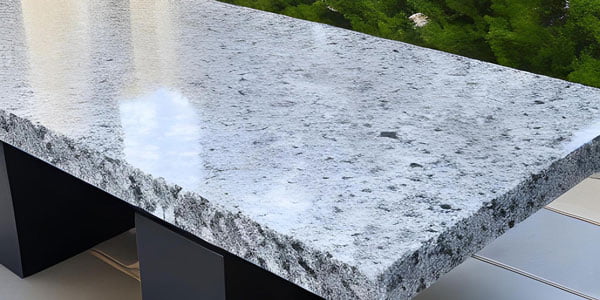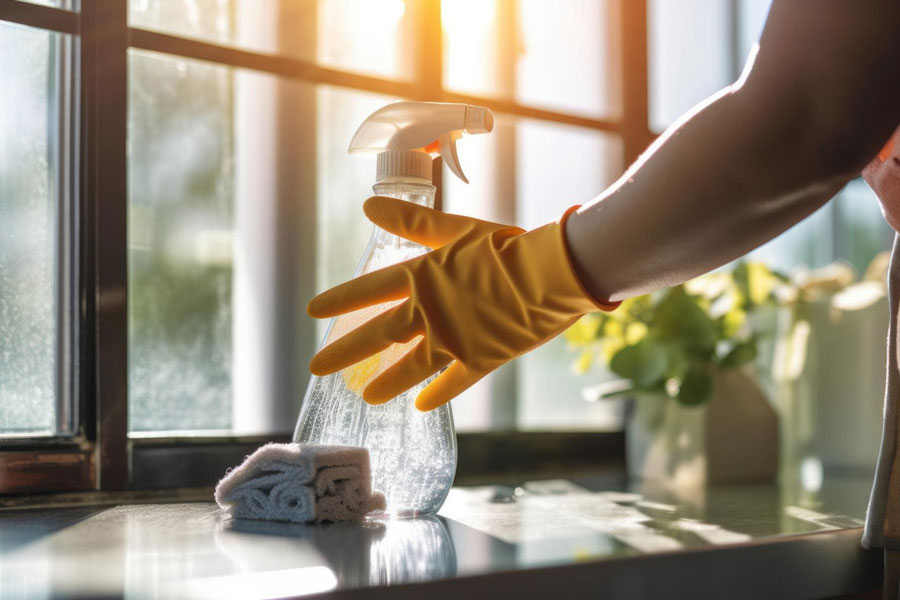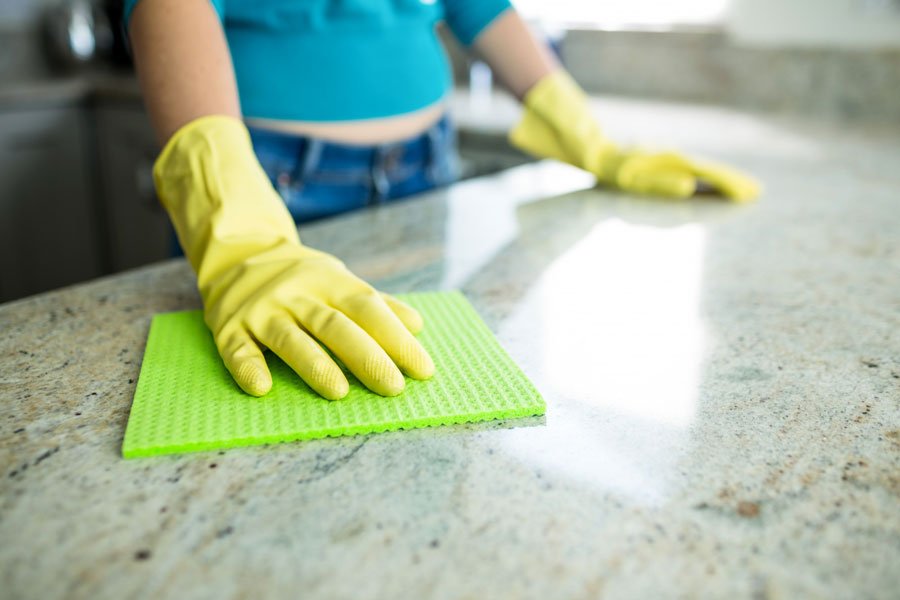Engineered stone benchtops are a popular choice for many homeowners in Sydney, as they offer durability, beauty, and variety. However, they also require proper care and maintenance to preserve their quality and appearance.
In this guide, I will show you exactly how to clean engineered stone benchtops using the best practices, tools, and solutions. We have over 20 years of experience in the stone industry and we have helped hundreds of clients in Sydney and beyond keep their benchtops in top condition.
Whether you have a gloss, matte, or textured finish, this guide will help you clean your engineered stone benchtops effectively and safely. Let’s get started.
What is Engineered Stone and Why is it Used for Benchtops?
Engineered stone is a man-made material that consists of natural stone particles, such as quartz, granite, or marble, and a resin binder. It is also known as quartz stone, composite stone, or reconstituted stone.
Engineered stone is widely used for benchtops in kitchens, bathrooms, and other areas, as it offers many advantages over natural stone. Some of these advantages are:
- It is more durable and resistant to scratches, chips, cracks, and stains.
- It is more uniform and consistent in color, pattern, and texture.
- It is more hygienic and non-porous, meaning it does not harbor bacteria or mold.
- It is more eco-friendly and sustainable, as it uses recycled materials and reduces quarrying and mining.
Engineered stone benchtops come in a variety of styles, finishes, and designs, making them suitable for any decor and preference. They can also be customized to fit any shape and size of the space.
Benefits of Engineered Stone Benchtops
- They are more durable and resistant to scratches, chips, cracks, and stains than natural stone.
- They are more uniform and consistent in color, pattern, and texture, making them easier to match and install.
- They are more hygienic and non-porous, meaning they do not harbor bacteria or mold and do not require sealing.
- They are more eco-friendly and sustainable, as they use recycled materials and reduce quarrying and mining.
Challenges of Engineered Stone Benchtops
- They are more expensive than some natural stone options, such as granite or marble.
- They are more sensitive to heat and can be damaged by hot pots or pans.
- They are more prone to etching and dulling by acidic substances, such as lemon juice, vinegar, or wine.
- They are more difficult to repair than natural stone, as they require professional services and sometimes replacement.
For more information about engineered stones, you can also read: Engineered Stone Benchtops: Everything you need to know

Daily Cleaning Routine for Engineered Stone Benchtops
The first step to keeping your engineered stone benchtops clean is to follow a simple daily routine. This will prevent dirt, dust, and grease from building up and damaging the surface.
Here’s what you need to do:
- Wipe the benchtop with a soft cloth or sponge and warm soapy water. Avoid using harsh or abrasive cleaners, as they can scratch or dull the surface.
- Rinse the benchtop with clean water and dry it with a microfiber cloth. This will prevent water spots and streaks from forming.
- For extra shine, you can spray the benchtop with a mild glass cleaner and buff it with a soft cloth.
That’s it. That’s all you need to do to keep your benchtops clean on a daily basis. But what if you encounter some stubborn stains or spills? Don’t worry, I have you covered.

Weekly Cleaning Routine for Engineered Stone Benchtops
Once a week, you should give your benchtops a deeper cleaning to remove any bacteria, germs, or odors that may have accumulated. This will also help to preserve the natural beauty and luster of the stone.
Here’s how to do it:
- Spray the benchtop with a disinfectant cleaner that is suitable for engineered stone. You can find these products at most supermarkets or hardware stores. Make sure to read the label and follow the instructions carefully.
- Let the cleaner sit for a few minutes to kill any germs or bacteria.
- Wipe the benchtop with a clean cloth or sponge and rinse it with water.
- Dry the benchtop with a microfiber cloth and polish it with a glass cleaner if desired.
That’s all there is to it. Your benchtops will look and smell fresh and clean. But what if you have some scratches, chips, or stains that won’t come off with regular cleaning?
How to Remove Stains, Scratches, and Chips from Engineered Stone Benchtops
Engineered stone benchtops are resistant to most stains, scratches, and chips, but they are not immune to them. Sometimes, accidents happen and you may end up with some marks or damage on your benchtops. The good news is that most of these issues can be fixed with some simple methods.
Here’s what you can do:
For stains
You can try using a poultice. A poultice is a paste made of an absorbent material and a solvent that can draw out the stain from the stone. You can make your own poultice by mixing baking soda and water, or you can buy a ready-made one from a hardware store. Apply the poultice to the stain and cover it with plastic wrap. Leave it for 24 hours and then remove it. Wipe the area with a damp cloth and repeat if necessary.
For scratches
You can try using a fine-grit sandpaper or a polishing pad. Gently rub the scratch with the sandpaper or pad until it fades. Be careful not to overdo it, as you may damage the surface. Wipe the area with a damp cloth and polish it with a glass cleaner.
For chips
You can try using a repair kit. A repair kit is a set of tools and materials that can fill in the chip and match the color and texture of the stone. You can find these kits online or at some hardware stores. Follow the instructions carefully and apply the filler to the chip. Smooth it out and let it dry. Sand it lightly and polish it with a glass cleaner.
That’s how you can fix most of the common problems that may affect your engineered stone benchtops. But how can you prevent them from happening in the first place? I have some tips for you.
How to Seal and Protect Engineered Stone Benchtops?
One of the best ways to keep your engineered stone benchtops clean and beautiful is to seal and protect them. Sealing and protecting your benchtops will make them more resistant to stains, scratches, and chips, and will also enhance their shine and color.
Here’s how to do it:
- Choose a sealer that is designed for engineered stone. You can find these products online or at some hardware stores. Make sure to read the label and follow the instructions carefully.
- Clean the benchtop thoroughly with warm soapy water and dry it with a microfiber cloth.
- Apply the sealer evenly over the benchtop with a soft cloth or sponge. Avoid getting the sealer on the sink, faucet, or backsplash.
- Let the sealer dry for the recommended time, usually a few hours.
- Buff the benchtop with a clean cloth and enjoy the results.
That’s how you can seal and protect your engineered stone benchtops. You should repeat this process every 6 to 12 months, depending on the usage and condition of your benchtops. But there are some other things you should avoid doing to keep your benchtops in good shape.
Common Mistakes to Avoid When Cleaning Engineered Stone Benchtops
Engineered stone benchtops are easy to clean and maintain, but there are some common mistakes that people make that can damage or ruin them.
Here are some of the things you should avoid doing when cleaning your benchtops.
- Don’t use harsh or abrasive cleaners, such as bleach, ammonia, vinegar, or scouring pads. These can scratch, etch, or discolor the surface of the stone.
- Don’t use knives, scissors, or other sharp objects directly on the benchtop. These can cause scratches or chips on the surface. Use a cutting board instead.
- Don’t place hot pots, pans, or dishes directly on the benchtop. These can cause thermal shock or cracks on the surface. Use a trivet or a mat instead.
- Don’t spill acidic or oily substances on the benchtop. These can cause stains or dullness on the surface. Wipe them up immediately with a damp cloth and a mild cleaner.
- Don’t leave wet or damp items on the benchtop. These can cause water spots or mold growth on the surface. Dry them off with a microfiber cloth or a paper towel.
That’s how you can avoid some of the common mistakes that people make when cleaning their engineered stone benchtops. By following these tips, you can keep your benchtops clean and beautiful for a long time.
Conclusion
Now you know how to clean engineered stone benchtops like a pro. You have learned the best practices and tips for daily, weekly, and deep cleaning, as well as how to remove stains, scratches, and chips, how to seal and protect, and how to avoid common mistakes.
Which tip from today’s post are you going to try first? Do you have any other questions or suggestions about cleaning engineered stone benchtops?
Either way, let me know by leaving a comment below right now. And don’t forget to share this post with your friends and family who have engineered stone benchtops. They will thank you for it.
